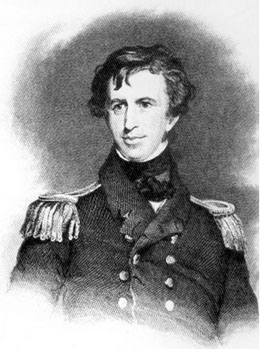On May 11, 1841, the U.S. Navy ships Vincennes and Porpoise, commanded by Lt. Charles Wilkes (1798-1877), drop anchor in southern Puget Sound, near the mouth of Sequalitchew Creek and the Hudson's Bay Company's Fort Nisqually. Wilkes' crew proceeds to chart Puget Sound and name numerous landmarks, including Elliott Bay. This United States Exploring Expedition marks America's first formal entry into Puget Sound waters.
Wilkes was an ambitious and autocratic officer who took command of the United States Exploring Expedition in 1838 with the aim of circumnavigating the globe and charting Antarctica and the Pacific Coast of North America. By the time he returned to Norfolk, Virginia, in 1842, his fleet of six ships had dwindled to two.
Which "Elliott" Gets the Bay?
The expedition dropped anchor at Discovery Bay on May 2, 1841, precisely 49 years after Capt. Vancouver, and then proceeded south into Admiralty Inlet. It arrived at the mouth of Sesquilatchew Creek on May 11 and approached Fort Nisqually unsure of the welcome it would receive from its British residents. The Hudson's Bay Company turned out to be a good host, and Wilkes established a scientific observatory near the fort.
On May 17, Porpoise Master George Sinclair chose "Commencement Bay" as the point at which to begin a detailed survey of upper Puget Sound. Wilkes was not impressed by the data on the waters off the future city of Seattle -- "I do not consider the bay a desirable anchorage" -- but he did name it "Elliott Bay." Unfortunately, Wilkes did not specify the eponym. There were three Elliotts in his crew: ships' boy George, chaplain Jared, and Midshipman Samuel. Although many historians have assumed that the pious Rev. J. Elliott was the honoree, Murray Morgan believes that Wilkes had the more amiable Samuel Elliott in mind (Puget's Sound, p. 53).
First Fourth of July Celebration on Puget Sound
Dr. John P. Richmond had established an American-led Methodist mission near Fort Nisqually in 1840. On July 5, 1841, Wilkes marched his crew from the shoreline to the mission to celebrate the Fourth of July (a day late because the Fourth fell on the Sabbath that year) for the first time in the Pacific Northwest. The parade and Richmond's speech, which declared the inevitability of American control of Oregon, subjected the fort's British subjects to a deliberately provocative display of American patriotism. Wilkes left the Sound soon after and sailed down the Pacific Coast, around Cape Horn, and back to Virginia.
Upon his return to the East Coast, word of Wilkes' harsh discipline and personal arrogance earned him public rebuke and inspired Herman Melville's most famous character, Captain Ahab. Only 100 copies of the expedition report were published, but they helped to establish Oregon and Puget Sound as new prizes for America's manifest destiny.

